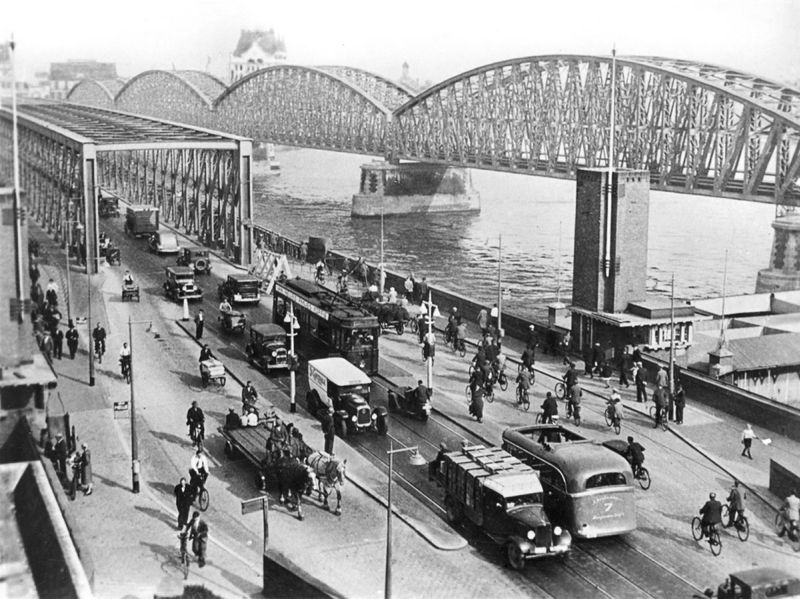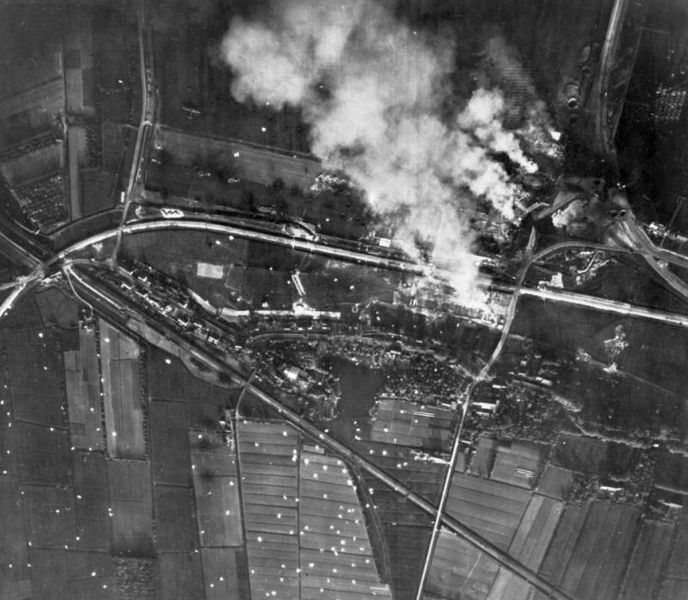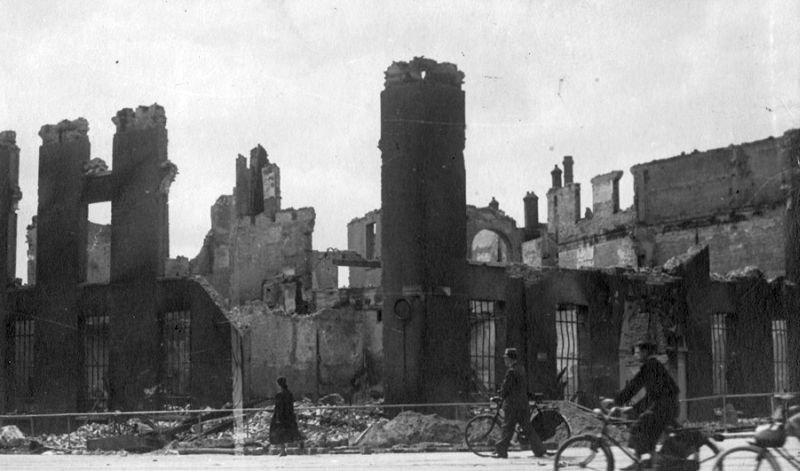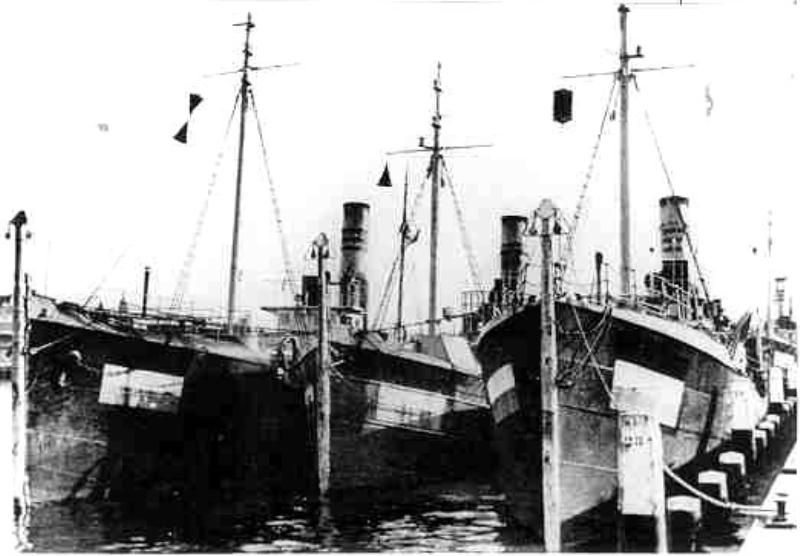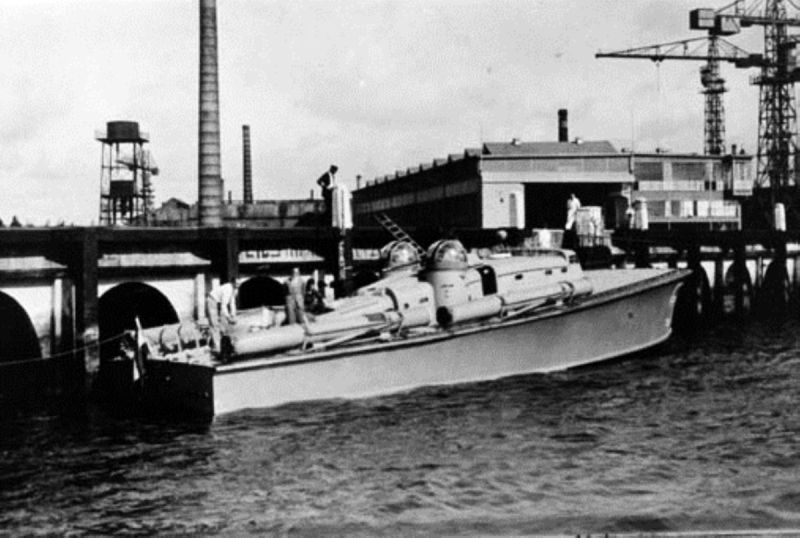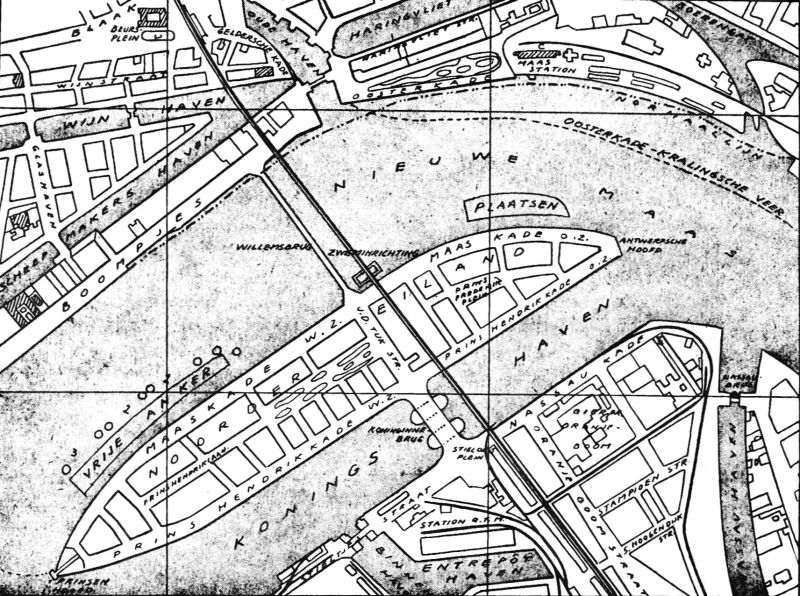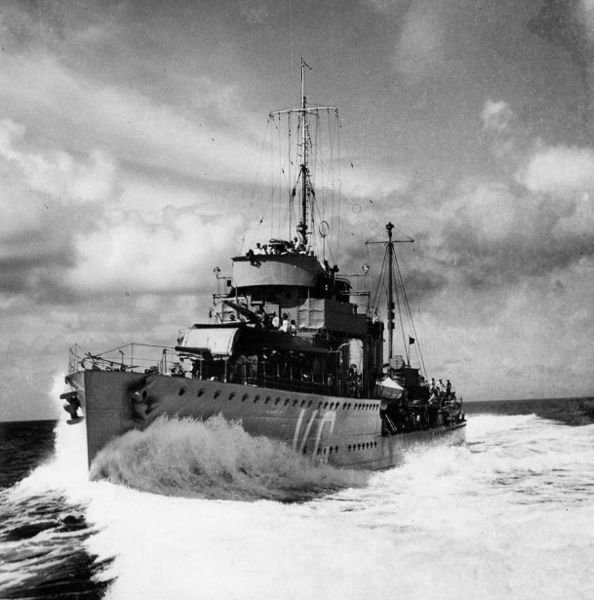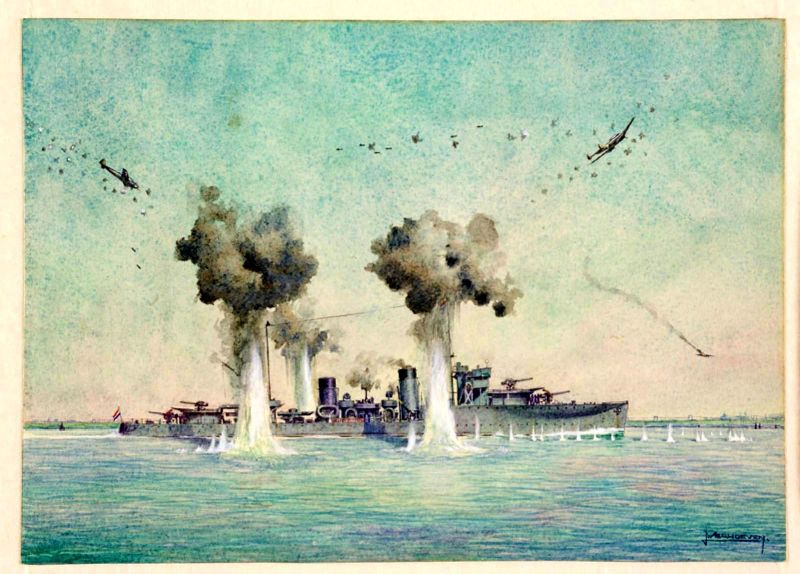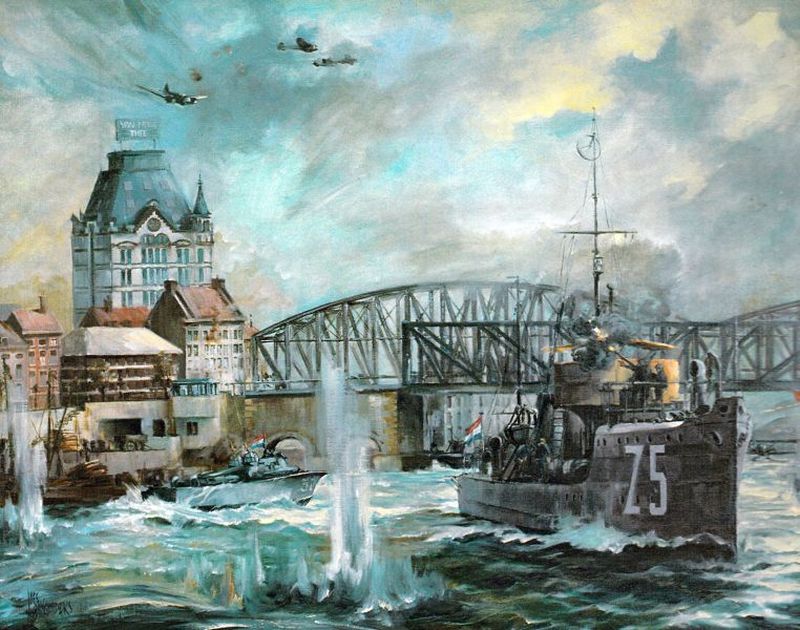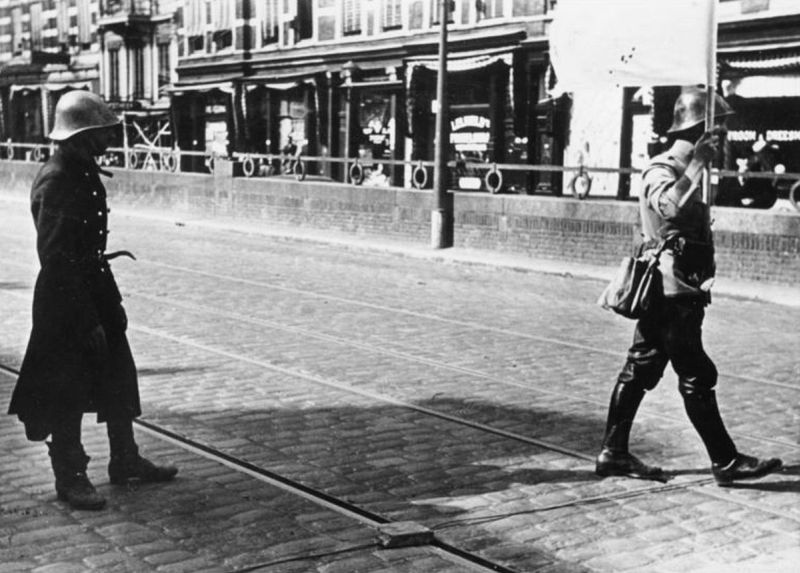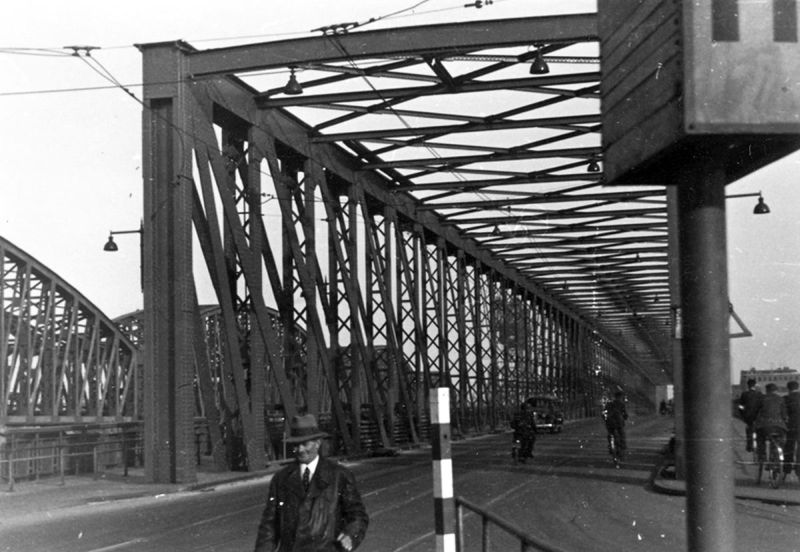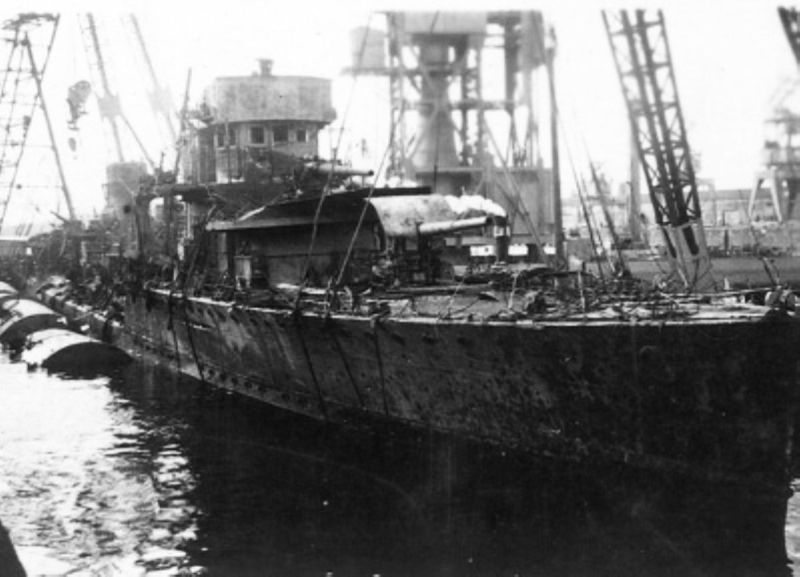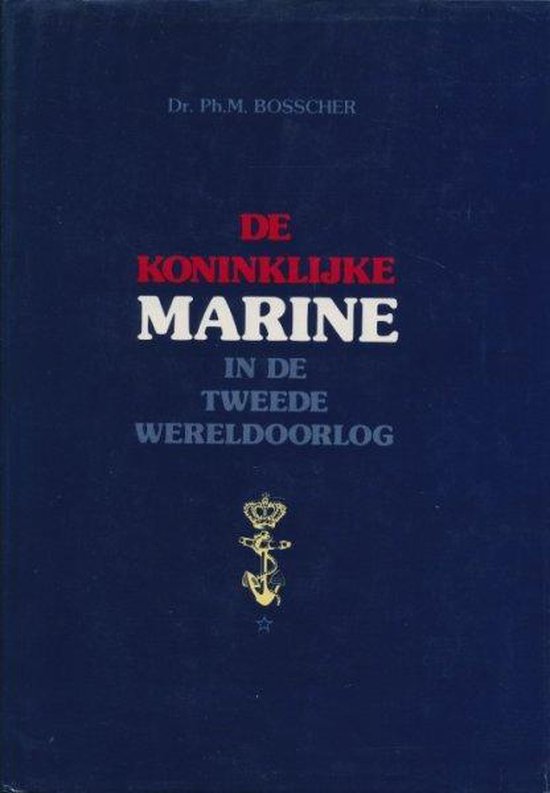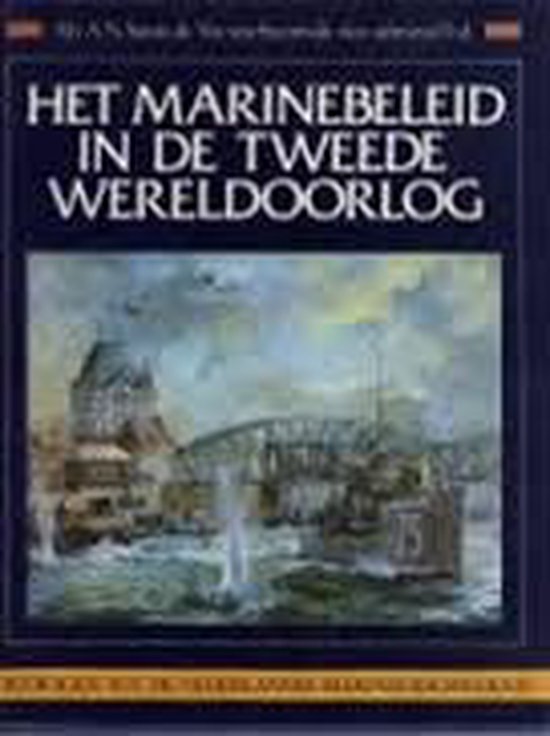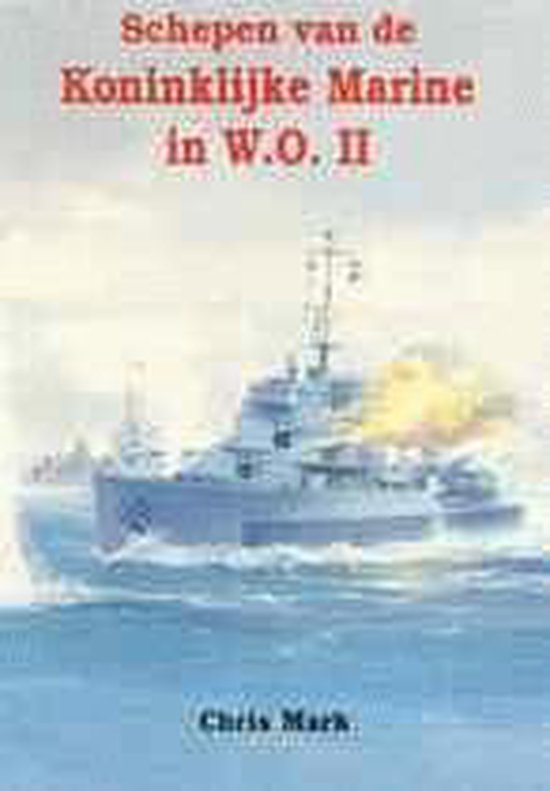Prologue
In the early morning of May 10, 1940, the Koninklijke Marine in Rotterdam joined the battle for the Maas bridges. Although the daring and courageous deployment of some Dutch warships initially seemed to have a positive influence on this battle, the tide turned quickly and that same afternoon, the navy lost one of her eight valuable destroyers. Infantry men, Marines and fleet personnel held out on the northern bank of the Nieuwe Maas until the general capitulation on May 14.
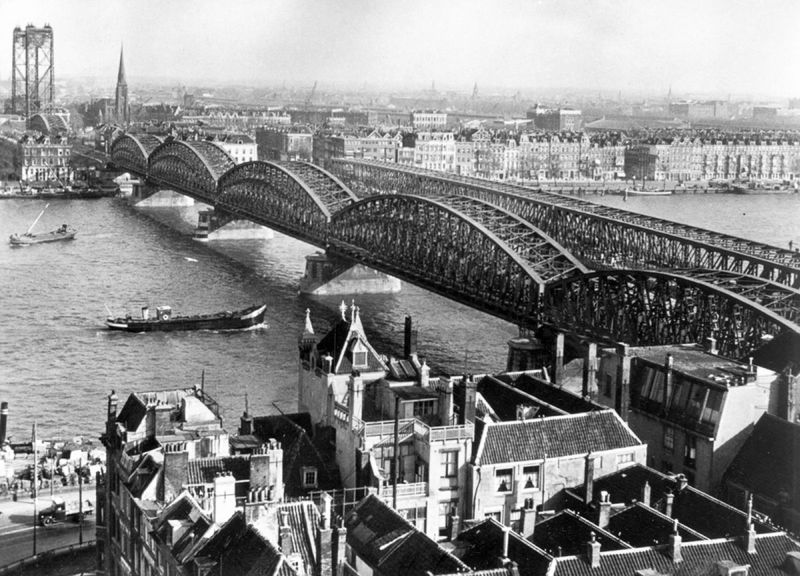
The bridges on the Maas in Rotterdam, the goal of a ferocious battle in May 1940 Source: Zuidfront Holland 1940
On Friday, May 10, 1940, the first messages came in about German troops crossing the border into the Netherlands. From Nieuweschans in Groningen to Vaals in Limburg German divisions of 6. and 18. Armee of Heeresgruppe B were moving up. At 03:55 the airbases of Waalhaven, Schiphol, Bergen, De Kooy on Texel, Gilze-Rijen, Haamstede, Souburg and the airfields around The Hague were bombed. After these raids, parachutists were dropped on Waalhaven near Rotterdam and the three airfields near The Hague - Ypenburg, Ockenburg and Valkenburg. At 05:30, these paras were followed by airborne troops on the airfield near Rotterdam.
Without encountering much resistance, the Germans crossed the river Maas in Limburg, captured the bridges near Moerdijk, on the Oude Maas near Dordrecht and on the Nieuwe Maas in Rotterdam. Withing a few hours, the Germans had gained a foothold behind the Hollandse Waterlinie in the center of Fortress Holland while the road to the seat of government, The Hague, lay virtually wide open. The obvious goal of the Germans was to overrun the center of government by the quick capture of the bridges at the Moerdijk, Dordrecht, Zwijndrecht and the Maas bridges in Rotterdam in order to force a quick surrender.
The Dutch General Staff had not reckoned with such a plan and consequently, no measures were taken to repulse such an attack. In Rotterdam, no defensive line was established but a large number of military was billeted in town. This force numbered some 7,000 men but of those, only 1,000 were ready for battle. The remaining 6,000 men consisted of military with only a sketchy basic training and logistic units. At the time, Rotterdam was the home base of the Etappen- en Verkeersdienst (EVD) of the army and furthermore there were depots of the engineers, air force and navy.
The presence of the navy in Rotterdam was rather extensive and consisted mainly of the barracks of the Marines and a detachment of the Korps Mariniers of some 300 men. Of these, only some 100 were well trained. A second part of the navy consisted of the so-called Marinedepot on the Mecklenburglaan. This depot housed 150 recruits of the Korps Mariniers and 450 zeemiliciens (conscripts including 300 men of classes 1927 and 1928) who had been drafted recently. Furthermore, there were 84 officers and NCOs of the Koninklijke Marine on some shipyards in Rotterdam where navy vessels were under construction and 16 crew members of the old river gunboat Hr. Ms. Balder which was in maintenance in Bolnes.
The navy contingent was directly subordinate to the Secretary of Defense but their commander, Kolonel der Mariniers H.F.J.M.A. von Frijtag Drabbe had been ordered to cooperate with the army when necessary to defend the city. Kolonel der Genie P.W. Scharroo, commander of the army in Rotterdam, wasn't in an enviable position. He only had a limited number of troops on direct alert at his disposal and the command structure was unclear because of the uncertain deployment of the navy personnel. Therefore, no coordinated action by the military in Rotterdam had been prepared.
Definitielijst
- capitulation
- Agreement between fighting parties concerning the surrender of a country or an army.
- Heeresgruppe
- The largest German ground formation and was directly subordinate to the OKH. Mainly consisting of a number of “Armeen” with few directly subordinate other units. A Heeresgruppe operated in a large area and could number several 100,000 men.
- resistance
- Resistance against the enemy. Often also with armed resources.
Battle of the bridges
On May 10, 1940 at 05:00, 12 Heinkel He-59D twin-engine seaplanes touched down, one after the other on the Nieuwe Maas on both sides of the Maas bridges. Some 80 to 90 German soldiers from these aircraft paddled in rubber dinghies to both banks and occupied the bridges and the surroundings. Soon they were reinforced by some 50 paratroopers who had landed near the Feyenoord stadium. Some of them took up positions on the Boompjes, the Wijnhaven, the Maas railway station and the Noordereiland. A little later, a battalion of airborne troops, which had landed on Waalhaven and had fought their way into the city, arrived to reinforce the attackers. The Germans now numbered some 500 strong.
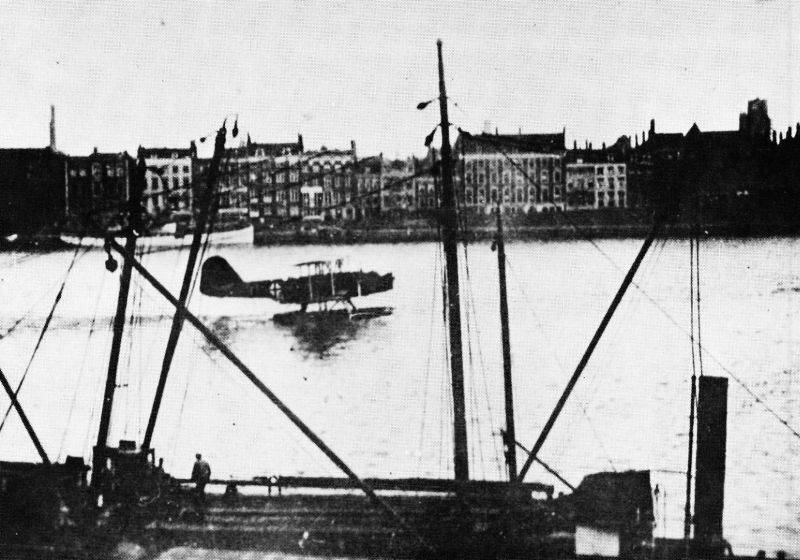
A German Heinkel He-59D on the Nieuwe Maas, in the background de Boompjes, May 10, 1940 Source: Peter Kimenai
Despite the fact that no coordinated plans for defense existed in Rotterdam, the Germans near the Maas bridges were soon subjected to fire from infantry and Marines.They had a number of heavy and a few dozen light machineguns at their disposal and drove the Germans from the Maas hotel which shortly before had been occupied by them as well as the building of the Nationale Verzekeringsbank. On the northern bank, the Germans retained their only bridge head, the building mentioned before. Thereafter, Dutch troops captured the White House, the tallest building on the northern bank of the Maas from where they had a clear field of fire on the bridges. German soldiers on the 360 yards long Willemsbrug, which ended right across from the White House, or wanting to cross it came under fire from the Dutch military. The Germans failed to reach their strongpoint on the far side of the Nieuwe Maas.
The Divisie Mijnenvegers III, (minesweepers), consisting of the confiscated trawlers Hr. Ms. Walrus, Azimuth, Alkmaar, Hollandia and the buoy vessel Hr. Ms. Aneta, had entered Hoek van Holland in the afternoon of May 9. Earlier that day, the division had made a sweep between Vlissingen and the Hoek. Early next morning, at 05:50 the converted fishing vessels were ordered by the chief of the navy staff, vice-Admiraal J. Th. Furstner to set sail for Rotterdam to assist with stopping the German troops that wanted to cross the Maas bridges. Two of the five vessels moored at the Parkkade where the division commander, Luitenant-ter-Zee 1st class W.E.F. Hazebroek wanted to ask for further orders. He was ordered by telephone to lend air support with two of his minesweepers armed with 12,7mm machineguns to the destroyer Hr. Ms. Z 5 which was arriving from the North Sea where she had patrolled the mouth of the Maas. The remaining three were to take cover alongside moored merchantmen and wait.
Hr. Ms. Z 5, a destroyer of 263 ton, armed with two 7.5cm Bofors guns and two 12,7mm Browning machineguns, entered the Nieuwe Waterweg around 06:00. The vessel, constructed during World War One, was equipped with a Degaussing cable which protected her from the magnetic mines which had been dropped in the water by German aircraft. After her commander, Luitenant-ter-Zee 1st class Van Lier had received information at the Parkkade, the destroyer steamed towards the Maas bridges at around 08:00. The vessel was accompanied by the two auxiliary minesweepers and MTB Hr. Ms. TM 51. This vessel of 32 ton had conducted tests with the torpedo tubes which weren't operational yet at the Gusto yard in Schiedam. The vessel was equipped however with two 20mm HS Hispano-Suiza machineguns in rotating turrets. Hr. Ms. Z 5 opened fire with her twin 7.5cm guns on the enemy machinegun emplacements on the Willems brug and a few German floatplanes. Two aircraft were destroyed and the German gun crews were dispersed. In response, the Germans set up a number of heavy machineguns on the Prinsenhoofd. The fire from these guns caused a few casualties aboard Hr. Ms. Z 5 who could remain at their action stations though.
During the second attack of the Dutch warships on the Maas bridges, they were strafed by German bombers, causing damage to Hr. Ms. TM 51 by shrapnel from a near miss. In addition, the bombers claimed one dead and one seriously injured aboard the vessel. Consequently and because one of the Rolls Royce engines and one of the machineguns showed technical problems her commander, Luitenant-ter-Zee 2nd class Van Staveren returned his MTB to the yard in Schiedam. After the commander of Hr. Ms. Z 5 had learned from his chief-constable the stock of 7.5cm shells had all but been depleted, he returned to Hoek van Holland with his destroyer. The five auxiliary minesweepers had also returned in the meantime and had berthed in the Lekhaven.
In the 'Beknopte Overzicht van de Krijgsverrichtingen der Koninklijke Landmacht 10-19 mei 1940' or summary of combat actions of the infantry, May 10 to 19, 1940, the actions of both destroyers were reported as follows: 'It would go too far to discuss the actions by the navy in detail so we'll have to limit ourselves to report the actions of Hr. Ms. destroyer Z 5 and Hr. Ms. destroyer TM 51 which vessels have seriously disturbed the crossing of the Maas bridges by German troops and temporarily delayed it,'
Definitielijst
- bridge head
- Area of conquered territory on other side of a (natural) obstacle from which the attacker can continue his advance.
- Browning
- American weapon’s designer. Famous guns are the .30’’ and .50’’ machine guns and the famous “High Power” 9 mm pistol.
- torpedo
- A weapon of war. A cigar shaped body fitted with explosives and a propulsion and control mechanism. Intended to target after launch a nearby enemy ship and disable it by underwater explosion.
Hr. Ms. Van Galen
While the battle of the bridges continued vice-Admiral Furstner, encouraged by the successful action of both destroyers, dispatched the destroyer Hr. Ms. Van Galen to Rotterdam. This vessel of 1316 ton and 320 feet long, had returned from the Dutch East Indies to Den Helder three days before in order to reinforce the defense of the fatherland. The ship suffered from a nasty problem of the Vickers 40mm machineguns called pompoms. These didn't function in elevated position, a problem that occurred on her seven sisterships as well. Despite this defect the vessel, at the time in port, received the order by 10:30 to set sail for Rotterdam in order to attack the Maas bridges. The order clearly stated: 'if necessary with full deployment of the vessel', so her commander Kapitein-luitenant-ter-Zee had no doubt at all about the urgency of his order.
Sailing at 24 knots, she raced towards Hoek van Holland where she arrived around 14:00. Along the way, off Ter Heide just south of Scheveningen, a dozen German aircraft were observed on the beach which had landed troops at low tide. She opened fire on these planes with her 12cm main battery without slowing down and destroyed two. Firing ceased when one of the shells overshot the dunes and came down in the village. At 18 knots her bridge protected against shrapnel with canvas, she entered the Nieuwe Waterweg to her doom. Off Vlaardingen, she was attacked by two formations of 15 Junkers Ju-87 dive-bombers which plastered the destroyer with bombs and their on-board guns. As her 40mm machineguns couldn't be used, she opened fire on the enemy planes with her 7.5cm gun only and her twin 12.7 machineguns which had little effect on the enemy aircraft. The large destroyer stood no chance against these aerial attacks because the water was too narrow to zig zag and evade the attacks.
Hr. Ms. Van Galen received no direct hits but a large number of near misses caused so much damage that the commander decided to seek shelter in a safe port. Arriving in the Merwedehaven, the crew steered the vessel against the quay to reduce speed and dropped anchor. The commander inspected his vessel and soon drew the conclusion she was out of action. Her hull had been torn open in various places and she was riddled by bullets and shrapnel. Much piping had burst and her stern was flooded. The order was given to abandon ship. Shortly after, the destroyer sank. The attacks had caused losses aboard Hr. Ms. Van Galen: 1 dead and 13 injured. Most of the remaining crew members joined the defenders of the city.
Consequences
After the war, the actions of Hr. Ms. Z 5 and Hr. Ms. TM 51 were documented extensively and recorded as heroic actions on canvas and papers but in fact, their contribution to the battle of the Maas bridges was only minor. They achieved not much more than what was recorded in the combat report: ….. disturbed the crossing of the Maas bridges by German troops and temporarily delayed it. By the way, Hr. Ms. Z 5 could have played a larger role in the fighting in Rotterdam because her stock of 7.5cm shells hadn't been depleted after all when she withdrew. The chief-constable, who had joined the crew only recently assumed to have found the magazine of the 7.5cm shells empty. He didn't know however that during her refit in 1931, the magazine had been divided in two by a water proof bulkhead. He had found only one of the magazines empty. He discovered and reported this later when the destroyer had already returned to Hoek van Holland. The role of the auxiliary minesweepers with their light armament of a few 12.7 and 7.7 mm machineguns was negligible. Even without the deployment of the navy vessels, the engineers, the sea recruits and Marines would have been able to hold out on the northern bank of the Maas until the bombing of Rotterdam and the general capitulation of the Dutch army on May 14 ended their resistance and compelled them to surrender.
The only positive effect the sacrificing of Hr. Ms. Van Galen had was that no more warships were sent in the direction of the Maas bridges. The gunboats Hr. Ms. Flores and Hr. Ms. Johan Maurits van Nassau were sent back from Hoek van Holland to respectively Vlissingen and Den Helder. The offer from the Royal Navy to send some British destroyers up the Nieuwe Waterweg was cordially rejected. All these vessels would probably meet the same fate as Hr. Ms. Van Galen
After the war, vice-Admiraal Furstner defended the deployment of Hr. Ms. Van Galen by arguing that he could hardly assess the risks the vessel ran in narrow waters by day. He had little experience as to the vulnerability of sailing ships to aerial attack. The information he did have was certainly no reason for the conclusion that an order, as given to Hr. Ms. Van Galen, was a hopeless mission. Less than a month earlier, the British cruiser HMS >Suffolk, after having shelled the airfield of Stavanger in Norway, she had managed to reach her home port in Scotland after having been attacked by the Luftwaffe for nearly seven hours on end.
Definitielijst
- capitulation
- Agreement between fighting parties concerning the surrender of a country or an army.
- cruiser
- A fast warship with 8,000 – 15,000 ton displacement, capable to perform multiple tasks such as reconnaissance, anti-aircraft defence and convoy protection.
- Luftwaffe
- German air force.
- resistance
- Resistance against the enemy. Often also with armed resources.
Epilogue
Hr. Ms. Z 5 managed to escape to England on May 14. She was handed over to the Royal Navy on March 2 (?) in order to transfer her crew to the new destroyer Hr. Ms. Tjerk Hiddes. The British commissioned Z 5 as escort vessel HMS Blade Her straight and sharp bow soon gained her the nickname Razor Blade. On April 9, 1945, the old vessel was returned to the Dutch navy which sold her to the demolishing company West of Scotland in Troon immediately which dismantled the vessel in October of the same year.
Hr. Ms. TM 51 also managed to escape to England on May 14 where the damage inflicted in Rotterdam was repaired on the yard of the British Power Boat Company at Hythe near Dover. The vessel was handed over to the Royal Navy which converted the vessel to Motor Gun Boat and commissioned her as HMS MGB 46. From June 2, 1941 until November 25, 1942, she was back in Dutch service as Hr. Ms. Panter. On the latter date, she was replaced by the more modern MGB 114. The British used HMS MGB 46 for a while as a training vessel but she was decommissioned before the end of the war.
The five auxiliary minesweepers of Divisie Mijnenvegers III had opened fire on various German aircraft on May 10 but without success. At anchor in the Lekhaven, the five converted trawlers were painted each night to minimize the risk of discovery during German air attacks. They went from gray to brown to green and ultimately to black. Nonetheless, on May 13 a series of bombs struck so close that some damage in the form of small leaks was inflicted by shrapnel. Therefore, on that afternoon the vessels moved to the Merwede haven. The next day, the vessels fell in German hands because the division commander hadn't deemed it necessary to scuttle the vessels. He thought that because of their age, the vessels wouldn't be of use to the occupier. The Germans however employed them in the Kriegsmarine as minesweepers. Four of the five vessels were lost in German service. Only Hr. Ms. Hollandia returned to the Netherlands in 1945, the Koninklijke Marine used her as a tugboat
In October 1941, the German occupier ordered Hr. Ms. Van Galen to be raised but the destroyer was beyond repair. Later on, the vessel was dismantled in Hendrik-Ido-Ambacht.
Definitielijst
- Kriegsmarine
- Germa navy. Part of the Wehrmacht next to Heer and Luftwaffe.
Information
- Article by:
- Peter Kimenai
- Translated by:
- Arnold Palthe
- Published on:
- 21-01-2023
- Last edit on:
- 30-09-2024
- Feedback?
- Send it!
Related sights
Related books
Sources
- BAART, J.J., Rotterdam Oorlogshaven, Walburg Pers, Zutphen, 2010.
- BEZEMER, K.W.L., Zij vochten op de zeven zeeën, Uitgeversmaatschappij W. De Haan N.V., Zeist, 1964.
- BOSSCHER, PH. M., De Koninklijke Marine in de Tweede Wereldoorlog deel 1, Uitgeverij T. Wever B.V., Franeker, 1984.
- MARK, C., Schepen van de Koninklijke Marine in W.O. II, De Alk bv, Alkmaar, 1997.
- MüNCHING, L.L. VON, Schepen van de Koninklijke Marine in de 2e wereldoorlog, De Alk bv, Alkmaar, 1978.
- VOS VAN STEENWIJK, A.N. DE, Het marinebeleid in de Tweede Wereldoorlog, De Bataafsche Leeuw, Amsterdam / Dieren, 1986.
